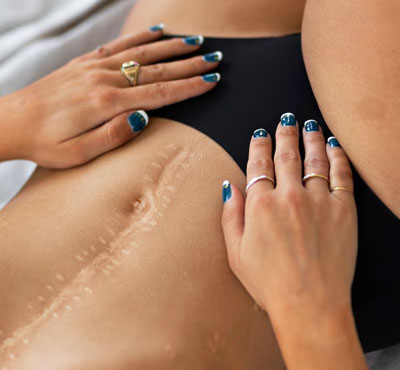Understanding Scars
Scars induced during skin repair due to injury or damage emerge due to an excess or a deficiency of collagen after healing while their appearance is impacted by different parameters, such as the nature of the wound, its depth, location and the skin type of the individual.
Common Types of Scars
- Hypertrophic Scars - These are hypertrophic scars caused due to excessive collagen deposition, which remain in the circumscribed area of the previous wound.
- Keloid Scars - Congenital scars that resemble hypertrophic scars, but do not stay within the borders of the scar, can be much larger, more prominent or unusual appearance.
- Atrophic Scars - Depressed scars are often associated with conditions like acne or chickenpox, where collagen production is insufficient.
- Contracture Scars - These scars arise after burns and are able to limit motion due to scarring of the skin.
- Stretch Marks - More technically a form of scar tissue, they form when a skin rapidly stretches as, for example, in pregnancy or when obesity occurs.
Advanced Scar Removal Treatments
At Dermavision - The Skin Clinic, we offer cutting-edge scar removal solutions tailored to your skin type and the nature of the scar.
Laser Therapy
Laser scar reduction treatment, including fractional CO2 and erbium lasers, are very effective for scar reduction in visibility. The lasers are based on the ablation of scar tissue, collagen production, and neocollagenesis with the proliferative growth of healthy keratinocytes. Laser treatment is used for all kinds of scars as itprovides significant improvement with little downtime.
Microneedling
Use of tiny needles to create multiple tiny punctures in the skin is known as Microneedling, which develops smoother and even skin from this procedure, boosting collagen synthesis and the body's natural healing reaction. Microneedling works well, particularly when used to address wrinkles and acne scars.
Peels of Chemicals
With chemical peels, the initial layer of skin is removed using certain solutions, which eliminates dysplastic cells and promotes the growth of healthy skin. This therapy improves the texture and tone of the skin and is comparatively successful for superficial scars.
Dermal Fillers
In the case of atrophic scars, dermal fillers can be employed not just to fill in hollows but to smooth the skin surface. Made from hyaluronic acid or other biocompatible materials, fillers provide immediate results and improve the appearance of scars.
Surgical Revision
For large or deep scars surgical revision could be advised. This requires the scar tissue to be excised and the wound to be sutured minimally to avoid scarring (1). Surgical scar revision is also commonly applied to contracture scars or scars from trauma.


